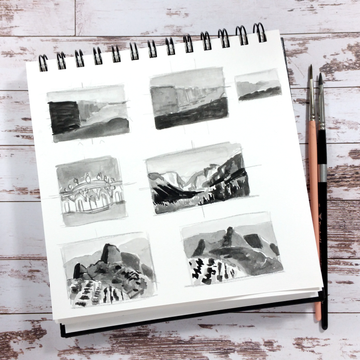So, you want to paint using a single color? That’s called working in monochrome. You may think, “Watercolor has so many gorgeous colors, why use just one?” Now, this is where things get interesting.
The basic idea of painting in monochrome is to choose one color, any color, and to work with it. It forces us, as artists, to shift our focus to a few aspects of our craft rather than having to manage all of it in the same painting.
Using a single color to do a painting, a sketch, a study, lets you work without having to think about the other colors. Forget mixing, today we think about light and shadows, contrast and composition!
Watercolor for monochrome paintings.
If your medium of choice is watercolor, you end up with two main colors: the color of the paper and the color you picked. Since watercolor can be diluted with water, that gives you a range from the strongest application of the paint to the lightest touch of color. You now have a span of values from light to intense.
Using a color with a dark mass tone, like black, will give you a wider range than using a color like yellow. Both can work, one just has to figure out what kind of effect they want to achieve. Do you want to focus on more dramatic lighting or on a softer light and feel?

Using your reference.
There are many ways to work with a reference for monochrome art. You can convert the image to black and white, or find a film noir movie to draw inspiration from. Vintage photographs can be a very nice reference, too. If your subject is in color and you can’t really change it, as in the case of live sketching, that’s when your art brain gets the biggest workout. Looking at the scene, you should ask yourself these four questions:
Which area gets the most light?
The lightest area is the one you would generally try to keep the closest to the color of the paper, even if what it’s depicting isn’t actually the color of the paper. Most watercolor paper is white or natural white, so that’s your lightest color. It’s also easier to add paint than to remove it, so if your lightest area is too light in the end, you can layer a wash of paint over it.
Which area gets the least light or where is the darkest shade?
It's good to keep this in mind so that you remember that you don’t need to detail this space. It’s gonna be in the shade, anyway.
Where is the strongest, sharpest contrast?
Our eyes are drawn to contrast. If you see that the most contrast is on an item that distracts from the subject of the piece, you might want to make that item less contrasted.
What appeals to you the most in the scene?
When painting from reference, you might want to highlight everything you can resulting in a very confusing monochrome piece. By trying to choose only one “favorite part” of the scene, you'll know that that’s what you have to focus on. That’s your subject.
Painting in monochrome is something we like to call an “art brain workout” because, like any other workout, it will get better and easier with every repetition (there are some awful workout days, just like we have bad art days, so they have that in common as well!).
Working with a single color can be a great way to study composition, if that’s something you want to work on. You can work quickly, focus on the shapes and where they sit in the image, and test things out. Watercolor will give you a good selection of values to use for this kind of practice.

Why choose watercolor as a medium for this?
First of all - it’s very easy to carry! You just need one color for this, so you can easily prop a paint pan in a small tin and set out. There’s no need for a large mixing area, as we use only one color. If you’re familiar with urban sketching and painting outdoors, it can make for an even smaller kit to carry around.
If you’re new to this medium, it’s a very nice way to start out. Having just one tube of paint takes away the worry of selecting colors, which brand to get, finding a palette, etc.
You will also get familiar with the properties of watercolor without having to think about everything all at once. If you’re familiar with watercolor but want to get to know a color better, doing monochromatic work with that color will definitely help you get comfortable with it.
Another great element of watercolor for this is that you can build up layers. If you’re worried you’ll paint too dark, you can start lighter and gradually add more paint on top of previous layers to get to the darkness or contrast you want.
A few tips to leave you with...
Using a grey watercolor pencil to do a rough sketch as a base could be beneficial to you. The grey will blend in and be invisible on the finished painting.
If you don’t tend to use black watercolor in full-color paintings, this is a great way to get use out of those neglected pans and paints!
Have fun with it! Ultimately, that’s the most important thing of all, so do what you want with the color of your choosing. Go where your amazing art brain takes you!
Is painting in monochrome something you would like to try?
If it is, and you have further questions, feel free to drop us a comment down below. We'd love to help you explore this form of art :-)
Ready to take it up a notch? Check out our blog on mastering the monochrome!


